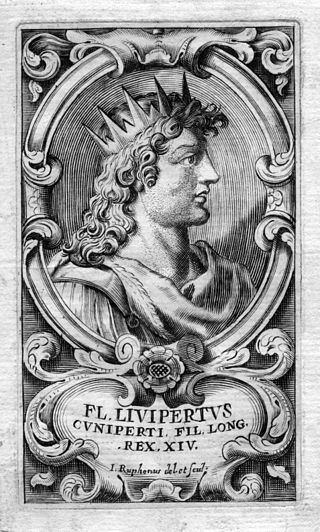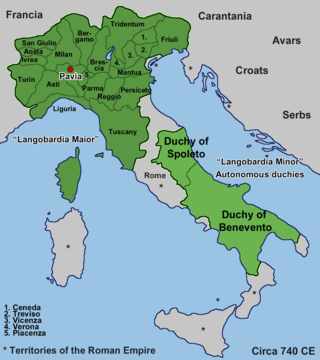
King of Italy was the title given to the ruler of the Kingdom of Italy after the fall of the Western Roman Empire. The first to take the title was Odoacer, a barbarian military leader, in the late 5th century, followed by the Ostrogothic kings up to the mid-6th century. With the Frankish conquest of Italy in the 8th century, the Carolingians assumed the title, which was maintained by subsequent Holy Roman Emperors throughout the Middle Ages. The last Emperor to claim the title was Charles V in the 16th century. During this period, the holders of the title were crowned with the Iron Crown of Lombardy.

Authari was king of the Lombards from 584 to his death. He was considered as the first Lombard king to have adopted some level of Romanitas (Roman-ness) and introduced policies that led to drastic changes, particularly in the treatment of the Romans and greater tolerance for the Christian faith.

Liutprand was the king of the Lombards from 712 to 744 and is chiefly remembered for his multiple phases of law-giving, in fifteen separate sessions from 713 to 735 inclusive, and his long reign, which brought him into a series of conflicts, mostly successful, with most of Italy. He is often regarded as the most successful Lombard monarch, notable for the Donation of Sutri in 728, which was the first accolade of sovereign territory to the Papacy.

Tassilo III was the duke of Bavaria from 748 to 788, the last of the house of the Agilolfings. He was the son of Duke Odilo of Bavaria and Hitrud, daughter of Charles Martell.
Odilo, also Oatilo or Uatilo of the Agilolfing dynasty was Duke of Bavaria from 737 until his death in 748. He had the Lex Baiuvariorum compilation edited, the first ancient Germanic law collection of the Bavarians.

Liutpert was the Lombard king of Italy between 700 and 702, with interruption. Upon succeeding his father, King Cunincpert, at a young age, he ruled together with his tutor, Ansprand, the duke of Asti. After eight months, he was deposed by Raginpert, the duke of Turin and son of Godepert, Liutpert's great-uncle, but succeeded in returning to the throne several months later upon Raginpert's death, only to be deposed again, taken captive from Pavia, and drowned by Aripert II, Raginpert's son. He was buried in the Basilica of Santissimo Salvatore in Pavia.

Aripert I was king of the Lombards (653–661) in Italy. He was the son of Gundoald, Duke of Asti, who had crossed the Alps from Bavaria with his sister Theodelinda. As a relative of the Bavarian ducal house, his was called the Bavarian Dynasty.

Perctarit was king of the Lombards from 661 to 662 the first time and later from 671 to 688.
Grimoald or Grimwald (†671) was a 7th-century King of Italy, ruling as Duke of Benevento from 647 to 662, and then as King of the Lombards from 662 until his death in 671.
The Bavarian dynasty was those kings of the Lombards who were descended from Garibald I, the Agilolfing duke of Bavaria. They came to rule the Lombards through Garibald's daughter Theodelinda, who married the Lombard king Authari in 588. The Bavarians were really a branch of the Agilolfings, and were themselves two branches: the branch descended in the female line through Garibald's eldest child and daughter, Theodelinda, and the branch descended from Garibald's eldest son Gundoald. Of the first branch, only Adaloald, Theodelinda's son by her second husband, whom she had chosen to be king, Agilulf, reigned, though her son-in-law Arioald also ruled. Through Gundoald, six kings reigned in succession, broken only by the usurper Grimuald, who married Gundoald's granddaughter:

Theodo, also known as Theodo V and Theodo II, was the Duke of Bavaria from 670 or, more probably, 680 to his death. It is with Theodo that the well-sourced history of Bavaria begins. He strengthened his duchy internally and externally and, according to the medieval chronicler Arbeo of Freising, he was a prince of great power whose fame extended beyond his borders.

The Kingdom of the Lombards, also known as the Lombard Kingdom and later as the Kingdom of all Italy, was an early medieval state established by the Lombards, a Germanic people, on the Italian Peninsula in the latter part of the 6th century. The king was traditionally elected by the very highest-ranking aristocrats, the dukes, as several attempts to establish a hereditary dynasty failed. The kingdom was subdivided into a varying number of duchies, ruled by semi-autonomous dukes, which were in turn subdivided into gastaldates at the municipal level. The capital of the kingdom and the center of its political life was Pavia in the modern northern Italian region of Lombardy.
Garibald I was Duke of Bavaria from 555 until 591. He was the head of the Agilolfings, and the ancestor of the Bavarian dynasty that ruled the Kingdom of the Lombards.
The Lethings were a dynasty of Lombard kings ruling in the 5th and 6th centuries until 546. They were the first Lombard royal dynasty and represent the emergence of the Lombard rulership out of obscurity and into history.
Gotfrid (also Gotefrid, modernized Gottfried; Latin: Gotfridus or Cotefredus; was the Duke of Alemannia in the late 7th century and until his death. He was of the house of the Agilolfing, which was the dominant ruling family in the Frankish Duchy of Bavaria.
Liutperga (Liutpirc) (fl 750 - fl. 793) was a Duchess of Bavaria by marriage to Tassilo III, the last Agilolfing Duke of Bavaria. She was the daughter of Desiderius, King of the Lombards, and Ansa.
Gundoald or Gundwald was a Bavarian nobleman of the Agilolfing family, a son of Duke Garibald I and Waldrada, and Duke of Asti from sometime around 589.
Gaidoald was the second Lombard duke of Trent, succeeding Euin in 595.
Gundeberga or Gundeperga,, was queen of the Lombards in 626-652 by marriage to the kings Arioald, (king of the Lombards; 626-636) and his successor Rothari, (king of the Lombards; 636-652). She acted as Regent during the minority of her son Rodoald after the death of her second husband in 652.









